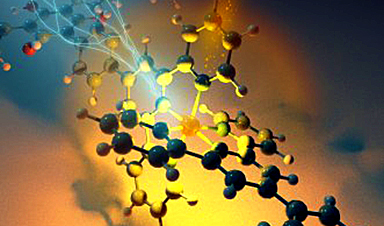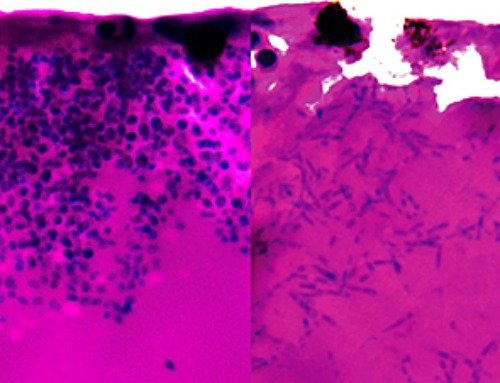| In the most powerful X-ray facilities in the world, scientists can analyze samples so small they contain only 10,000 atoms. Smaller sizes have proved exceedingly difficult to achieve, but a multi-institutional team has scaled down to a single atom. | |
| “X-ray beams are used everywhere, including security scanning, medical imaging and basic research,” said Saw Wai Hla, physicist in the U.S. Department of Energy’s (DOE) Argonne National Laboratory and professor at Ohio University. “But since the discovery of X-rays in 1895, scientists have not been able to detect and analyze just one atom. It has been a dream of scientists to be able to do so for decades. Now we can.” | |
| As just announced in Nature (“Characterization of just one atom using synchrotron X-rays”), scientists from Argonne and several universities report being able to characterize the elemental type and chemical properties of just one atom by using X-ray beams. This new capability will impact fundamental research in numerous scientific disciplines and development of new technologies. |
| The results from X-ray beams yield a sort of fingerprint for the type of elements in a material. For example, the NASA Curiosity rover gathered small samples of sand on the Martian surface, then determined with X-ray analysis that their content is similar to volcanic soil in Hawaii. | |
| Using powerful X-ray machines called synchrotron light sources, scientists can analyze samples as small as a billionth of a billionth of a gram. Such samples contain about 10,000 atoms. Smaller sizes have proved exceedingly difficult to achieve, but in an astonishing leap, the team managed to scale down their observations to a single atom. | |
| “The word transformative gets bandied about a lot, but this discovery I believe is truly a major breakthrough,” Hla said. “I was so excited I could barely sleep as I imagined possible uses in the development of batteries and microelectronic devices and even in environmental and medical research.” | |
| To characterize just one atom with X-rays, it needs to be isolated from the same kind of atoms. To do so, the team first entwined a single iron atom in a nanometer-size molecule composed of different elements. | |
| They then took the sample for analysis with the powerful X-ray beam at Argonne’s light source, the Advanced Photon Source (APS). The team detected the single atom in the sample at a beamline (XTIP) shared by the APS and the Center for Nanoscale Materials (CNM). Both are DOE Office of Science user facilities at Argonne. The beamline includes a scanning tunneling microscopy (STM) probe. | |
| “A DOE Early Career Research Program Award that I received in 2012 allowed me to form a team of passionate scientists and engineers to develop the microscopy technique used in this study,” said Volker Rose, physicist at the APS and in the CNM. “Together, we developed and built this one-of-a-kind microscope at the XTIP beamline thanks to additional DOE funding.” |
| The rush of photons from the X-ray beams bombard the sample, causing it to release electrons. Positioned less than a nanometer above the sample surface, the STM probe collects the electric signal due to the emitted electrons. The resulting spectra (plots of current versus photon energy) are “fingerprints” for the elements in the periodic table. Each element has a unique fingerprint. By probing the sample surface, scientists can thus identify an element of a particular atom and its exact location. | |
| There is more. They can also determine the atom’s chemical state from the same spectrum. The chemical state has to do with the fact that atoms can lose a certain number of electrons; for example, iron can lose two, three or four electrons. The chemical state reflects the number of electrons missing and is important for scientists to know because it affects the physical, chemical and electronic properties of the atom. | |
| To prove the new capability’s wider applicability, the team successfully repeated the same X-ray analysis with terbium, a rare earth element. Rare earths are critical to microelectronics, batteries, aircraft structures and more. The technique is applicable to elements besides metals as well. By knowing the properties of single atoms, scientists can then exploit their uses in materials in new ways. | |
| “Being able to study one atom at a time will revolutionize X-ray applications to an unprecedented level, from quantum information technology to environmental and medical research,” Hla said. |
News
Scientists Unlock a New Way to Hear the Brain’s Hidden Language
Scientists can finally hear the brain’s quietest messages—unlocking the hidden code behind how neurons think, decide, and remember. Scientists have created a new protein that can capture the incoming chemical signals received by brain [...]
Does being infected or vaccinated first influence COVID-19 immunity?
A new study analyzing the immune response to COVID-19 in a Catalan cohort of health workers sheds light on an important question: does it matter whether a person was first infected or first vaccinated? [...]
We May Never Know if AI Is Conscious, Says Cambridge Philosopher
As claims about conscious AI grow louder, a Cambridge philosopher argues that we lack the evidence to know whether machines can truly be conscious, let alone morally significant. A philosopher at the University of [...]
AI Helped Scientists Stop a Virus With One Tiny Change
Using AI, researchers identified one tiny molecular interaction that viruses need to infect cells. Disrupting it stopped the virus before infection could begin. Washington State University scientists have uncovered a method to interfere with a key [...]
Deadly Hospital Fungus May Finally Have a Weakness
A deadly, drug-resistant hospital fungus may finally have a weakness—and scientists think they’ve found it. Researchers have identified a genetic process that could open the door to new treatments for a dangerous fungal infection [...]
Fever-Proof Bird Flu Variant Could Fuel the Next Pandemic
Bird flu viruses present a significant risk to humans because they can continue replicating at temperatures higher than a typical fever. Fever is one of the body’s main tools for slowing or stopping viral [...]
What could the future of nanoscience look like?
Society has a lot to thank for nanoscience. From improved health monitoring to reducing the size of electronics, scientists’ ability to delve deeper and better understand chemistry at the nanoscale has opened up numerous [...]
Scientists Melt Cancer’s Hidden “Power Hubs” and Stop Tumor Growth
Researchers discovered that in a rare kidney cancer, RNA builds droplet-like hubs that act as growth control centers inside tumor cells. By engineering a molecular switch to dissolve these hubs, they were able to halt cancer [...]
Platelet-inspired nanoparticles could improve treatment of inflammatory diseases
Scientists have developed platelet-inspired nanoparticles that deliver anti-inflammatory drugs directly to brain-computer interface implants, doubling their effectiveness. Scientists have found a way to improve the performance of brain-computer interface (BCI) electrodes by delivering anti-inflammatory drugs directly [...]
After 150 years, a new chapter in cancer therapy is finally beginning
For decades, researchers have been looking for ways to destroy cancer cells in a targeted manner without further weakening the body. But for many patients whose immune system is severely impaired by chemotherapy or radiation, [...]
Older chemical libraries show promise for fighting resistant strains of COVID-19 virus
SARS‑CoV‑2, the virus that causes COVID-19, continues to mutate, with some newer strains becoming less responsive to current antiviral treatments like Paxlovid. Now, University of California San Diego scientists and an international team of [...]
Lower doses of immunotherapy for skin cancer give better results, study suggests
According to a new study, lower doses of approved immunotherapy for malignant melanoma can give better results against tumors, while reducing side effects. This is reported by researchers at Karolinska Institutet in the Journal of the National [...]
Researchers highlight five pathways through which microplastics can harm the brain
Microplastics could be fueling neurodegenerative diseases like Alzheimer's and Parkinson's, with a new study highlighting five ways microplastics can trigger inflammation and damage in the brain. More than 57 million people live with dementia, [...]
Tiny Metal Nanodots Obliterate Cancer Cells While Largely Sparing Healthy Tissue
Scientists have developed tiny metal-oxide particles that push cancer cells past their stress limits while sparing healthy tissue. An international team led by RMIT University has developed tiny particles called nanodots, crafted from a metallic compound, [...]
Gold Nanoclusters Could Supercharge Quantum Computers
Researchers found that gold “super atoms” can behave like the atoms in top-tier quantum systems—only far easier to scale. These tiny clusters can be customized at the molecular level, offering a powerful, tunable foundation [...]
A single shot of HPV vaccine may be enough to fight cervical cancer, study finds
WASHINGTON -- A single HPV vaccination appears just as effective as two doses at preventing the viral infection that causes cervical cancer, researchers reported Wednesday. HPV, or human papillomavirus, is very common and spread [...]





















